Abstract
With increasing societal attention being directed to resource and environment problems, the research focus on high reclaimed asphalt content mixtures has become pertinent. The degree of asphalt fusion in the thermal regeneration process of a high RAP content reclaimed asphalt mixture has a great influence on its performance. In order to explore the development process of hot in-place recycling mixture performance along with internal asphalt fusion, this study conducted research on a geothermal regeneration mixture with 80% RAP content. Dynamic shear rheology (DSR), infrared spectroscopy, and scanning electron microscopy were used to investigate the fusion of recycled mixture under different placement times (1 day, 4 days, and 7 days), and the road performance and fatigue life of the recycled mixture under different placement times were then studied. The results showed that the fusion degree of old asphalt and new asphalt in a recycled asphalt mixture reached 100%, and gradually increased with the extension of placement time. With the increase in placement time, the high temperature performance of the regenerated mixture gradually decreased, the water stability gradually increased, and the low-temperature performance and fatigue life significantly increased from 1 day to 7 days, by 19% and 32%, respectively.
1. Introduction
Environmental and resource concerns have garnered escalating attention in recent years. The maintenance and reconstruction of asphalt pavement following prolonged use will generate a substantial volume of RAP material [,]. Improper disposal of RAP can lead to environmental pollution and resource wastage [,,]. Therefore, the recycling of RAP is the best way to save nonrenewable resources and protect the environment; it is also the focus of social attention [,]. Currently, hot in-place recycling technology stands out as the pavement regeneration method with the highest RAP material recycling rate, the shortest cycle chain, and the lowest carbon emissions []. However, because of the substantial presence of RAP, the recycled mixture is prone to early diseases [,,].
The main problems of high RAP content recycled mixtures center on how to reasonably consider the fusion of blended asphalt in design [,]. There are three mainstream theories on the interface fusion effect of blended asphalt in the mixing process of recycled mixture. One theory is the early RAP “black rock effect” theory [,], which posits that there is no fusion between the aged and fresh asphalt; instead, the aged asphalt essentially integrates with the aggregate, commonly known as the “black stone” theory. Another theory is the “full fusion” theory, which emphasizes the complete and uniform fusion of fresh and aged asphalt, utilizing the fusion material as the binder of the mixture to enhance its mechanical and road performance, with the degree of fusion (DOF) of fresh and aged asphalt reaching 100%. One theory that is widely recognized by scholars is the “partial integration” theory [,,], which posits that only the outer portion of the asphalt in RAP material is activated by the new asphalt and regenerating agent, assuming the role of the binder and leading to fusion. Currently, in the process of designing mix ratios for recycled asphalt mixtures, it is assumed that the blended asphalt can achieve 100% fusion. However, numerous studies [,,,,] indicate that when the proportion of RAP is significant, complete integration of fresh and aged asphalt is not achievable through a brief mixing process.
Domestic and foreign scholars have conducted extensive research on how to interpret the DOF of blended asphalt in recycled mixtures from different perspectives. Song Zhao et al. [] employed molecular dynamics simulation software to reveal the interplay between aged and fresh asphalt mortars in recycled mixture from a microscopic perspective. Shisong Ren et al. [] used the thermal stability of recycled asphalt in the laboratory to verify the effectiveness of a molecular dynamics model in predicting the compatibility of a regenerated agent with aging asphalt, and explained the compatibility and stability of a regenerated agent with aging asphalt from a molecular perspective. Benjamin F. Bowers et al. [] conducted a quantitative investigation into the DOF of blended asphalt in RAP using gel permeation chromatography (GPC) and Fourier transform infrared spectroscopy (FTIR). LongTing Ding et al. [] studied the fusion of blended asphalt in the process of aged asphalt regeneration from both micro and macro aspects by employing the Hirsch model. Guilian Zou et al. [] proposed a new method for three-dimensional fluorescence imaging to observe and quantitatively characterize mixing phenomena. Yongjie Ding et al. [] introduced a FTIR-based method to assess the fusion efficiency of blended asphalt in the recycled mixture. Some studies have also been done on the impact of various factors on the degree of fusion during the mixing process at home and abroad. Shaopeng Wu et al. [] and Benjamin F et al. [] showed that blending temperature exerted the most significant effect on the DOF, followed by blending time, with no apparent impact observed from RAP content. To improve the DOF of blended asphalt, scholars have undertaken the following studies: Chao Yang et al. [] analyzed the performance of each asphalt layer using a layering extraction method. Their results revealed an uneven mixing of each layer within the asphalt mixture. Chamod Hettiarachchi et al. [] showed that extending the mixing time and increasing the mixing temperature could enhance the DOF of the blended asphalt. Various scholars have completed the following studies on the correlation between the recycled mix performance and the fusion degree. Danning Li et al. [] demonstrated a positive correlation between the DOF and the crack resistance of reclaimed rubber asphalt. Bingyan Cui et al. [] showed that a high temperature can improve the mutual diffusion coefficient between aged asphalt and original asphalt, indicating that a higher degree of fusion contributes to improved crack resistance in the mixture. Jie Gao et al. [] revealed that as the DOF of the recycled mixture increased, the occurrence of aggregate and asphalt stripping was alleviated, leading to an enhancement in water stability.
Currently, investigations into the DOF of recycled mixtures can be broadly classified into three types. The first type of research involves assessing the DOF in a recycled mixture through calculation. The second type focuses on characterizing the factors that affect the fusion degree of recycled mixture. The third type examines how the fusion degree of recycled mixture affects its performance. Studies show that the density and Marshall stability of recycled asphalt mortar increase with an increase in curing temperature and time []. The research of Teng Wang and Jinzhi Xu et al. [,] showed that as the placement time increases, the fusion degree of recycled mixture will continue to increase until complete fusion is achieved. It is not comprehensive to study the fusion of blended asphalt mixtures only at the mixing stage. The change of the fusion degree of recycled mixture with the passing of time, and the evolution of various properties with the change of fusion degree, are still to be studied. To characterize the development process of the early performance of recycled mixtures with changes in the degree of asphalt fusion, this study used the high-temperature rheological properties of extracted asphalt from recycled mixtures to reflect its DOF, and then characterized the development process of the road performance and fatigue life of recycled mixtures with the change of their internal degree of asphalt fusion. Finally, the form of the occurrence of asphalt fusion was studied from a microscopic perspective.
2. Materials and Preparation of Specimens
2.1. Materials
2.1.1. RAP
The RAP used in this paper came from the Zibo section of Qinglan Expressway in Shandong Province, China. The RAP material in this section was an SBS-modified asphalt mixture that had been aged for a long time after 10 years of service. In compliance with the stipulations of JTG E20-2011 [], the RAP material for this section was extracted, and then the extracted old asphalt and aggregate were tested to obtain the performance of the RAP. Table 1 and Table 2 show the relevant performance of RAP in this section.

Table 1.
Technical specifications of asphalt in RAP material.

Table 2.
RAP gradation.
2.1.2. New Asphalt and Regenerant
In this test, I-C SBS-modified asphalt was utilized, and its main properties were determined according to JTG E20-2011 []. Its performance test results are presented in Table 3; all performances conformed to the technical requirements outlined in JTG F40-2004 []. The regenerant employed in this test was HRA-II, and its performance is detailed in Table 4.

Table 3.
Technical specifications of new asphalt.

Table 4.
Technical specifications of HRA-II.
2.1.3. New Aggregates and Mineral Powder
This study used clean, dry, hard basalt as the new aggregate material. The mineral powder utilized was limestone. The technical specifications of the aggregates met the standards outlined in JTG E42-2005 [], and the technical indices are shown in Table 5, Table 6 and Table 7.

Table 5.
Technical index of coarse aggregate.

Table 6.
Technical index of fine aggregate.

Table 7.
Technical index of mineral powder.
2.2. Specimen Preparation
2.2.1. Preparation Method of Recycled Asphalt Mixture
The process flow of hot in-place regeneration is shown in Figure 1; RAP in this test was taken from the material after milling in the milling machine without adding regenerant. The flow method of preparing recycled asphalt mixture (RAM) in the lab is depicted in Figure 2. In the blending of the new asphalt mixture, the mixture was mixed following the procedures outlined in JTG E20-2011. The mixed asphalt mixture was placed in an oven at 170 °C. During the heating of the aggregate and asphalt, the RAP was subjected to an hour-long heat treatment at 170 °C in an oven. After heat preservation, the RAP was placed in a mixing pot at 170 °C for 90 s, and then the regenerant (after preheating at 145 °C for 30 min) was added to continue blending for 90 s. Ultimately, the new asphalt mixture was added to continue blending for 90 s.
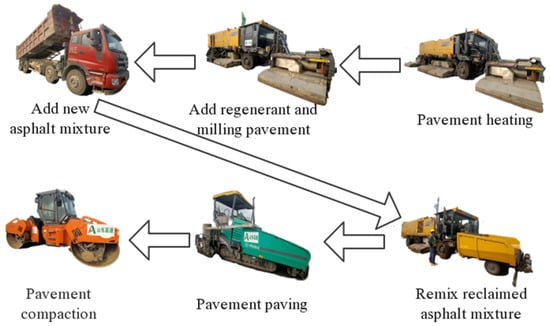
Figure 1.
Construction process of hot in-place regeneration.
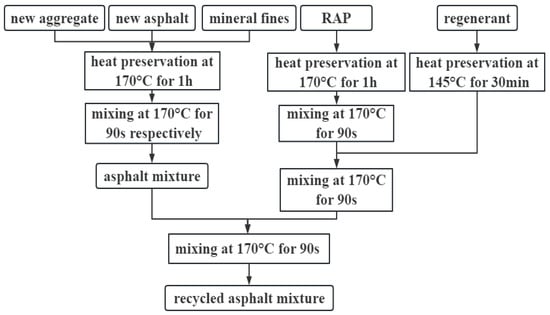
Figure 2.
The indoor process for preparing RAM.
2.2.2. Optimization of the Gradation of RAM
The gradation of the new aggregates usually does not take into account the damage to mineral material caused by the long-term service and milling process of RAP materials. Grading optimization involved taking into account the deterioration of the original pavement’s mineral material due to service and milling processes. Grading optimization was then carried out based on the principle of compensating for the missing components. The original gradation type of RAP material used in this test was SMA-13. After extended periods of service and milling, the gradation of the material was significantly compromised and fell short of the SMA-13 specifications outlined in JTG F40-2004. Consequently, it became necessary to introduce new aggregates to complement the RAP material’s gradation. This ensured that the overall gradation of the RAM complied with SMA-13 requirements. In this test, the RAP content was 80%, and the amount of newly added aggregate was calculated by Formulas (1) and (2) as follows:
where , , , …… is the grader retained percentage of the aggregate of each particle size of the target gradation, %. , , , …… is the grader retained percentage of the aggregate of each particle size of the RAP, %; is the amount of new aggregate, %. . If < 0, then set = 0, and then set = to get
where , , , …… is the grader retained percentage of the aggregate of each particle size of the newly added aggregate, %.
According to the above method, the amount of the new aggregate in this experiment was calculated. Subsequently, the calculated synthetic gradation of the RAM in this experiment is illustrated in Figure 3.
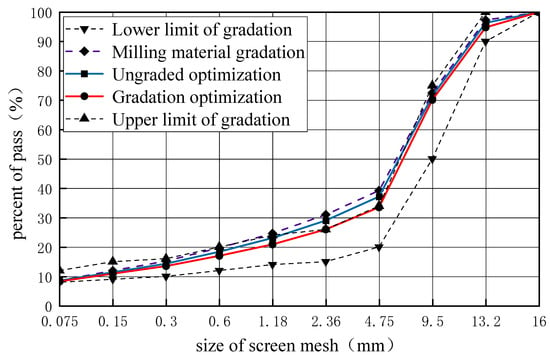
Figure 3.
Gradation of RAM.
2.2.3. Recycled Mixture Ratio Design
This study utilized an 80% RAP material content with a 4% regenerant dosage. The type of RAM selected in this test was still SMA-13. Mixtures with oil/stone ratios of 5.8%, 6.0%, 6.2%, 6.4%, and 6.6% were prepared, and the volumetric properties of each mixture were measured. The test results are shown in Table 8. The optimum oil/stone ratio of this test was 6.4%.

Table 8.
Marshall volume parameters of each oil/stone ratio.
3. Experimental Methods
3.1. Characterization of the Degree of Fusion
RAP materials with a particle size less than 9.5 mm were obtained by excluding those with a size greater than 9.5 mm. Subsequently, an extraction test was conducted on the RAP material below 9.5 mm to determine its asphalt content, which was found to be 6.45%. All newly added aggregates were 13.2–16 mm. This study termed the blend of new and old asphalt in RAM as blended asphalt. In order to simulate the real-life situation of recycled materials in this study, the ratio of fresh and old asphalt was consistent with the proportion of fresh and aged asphalt under the condition of the 6.4% oil/stone ratio in the previous material. According to the optimal oil/stone ratio of 6.4% determined above, the ratio of aged and fresh asphalt in the recycled material was 21:100, and the amount of new aggregate was still 20%. After mixing, the mixture was uniformly divided into three portions, which were placed at room temperature (30 °C) for 1 day, 4 days, and 7 days, respectively. After the placement time was reached, the parts larger than 13.2 mm were separated in the RAM. Coarse and fine asphalt materials were obtained through extraction tests, and then the mixed asphalt was prepared. The blended asphalt was prepared by mixing the regenerant and the new asphalt in accordance with the proportions specified for the RAM. The mixture was cut at a shear rate of 3000 r/s at 170 °C for 20 min to form a mixed asphalt. Finally, DSR tests were conducted on the obtained asphalt and its complex shear modulus (CSM) was tested. According to Formula (3), the DOF of the blended asphalt of the RAM was calculated as follows:
where DOF is the degree of fusion in the reclaimed asphalt mixture, %. is the complex shear modulus of the asphalt on aggregates above 13.2 mm, MPa. is the complex shear modulus of the asphalt on aggregates below 9.5 mm, and MPa. is the complex shear modulus of the blended asphalt, MPa.
3.2. Performance Test
Evaluations for the RAM were carried out following the testing procedures outlined in the Standard Test Methods of Bitumen and Bituminous Mixtures for Highway Engineering (JTG E20-2011). These evaluations included high-temperature rutting, low-temperature bending, freeze–thaw splitting, immersion Marshall, and splitting fatigue tests. Tests were conducted on RAM placed at room temperature (30 °C) for 1 day, 4 days, and 7 days to evaluate how placement time affects the above performance.
3.2.1. Water Stability Test
Specimens were divided into two groups; one group underwent freeze–thaw cycles, and the other group did not undergo treatment. Subsequently, the two sets of specimens were immersed in water at 25 °C for 2 h and the splitting strength was measured. The TSR of the mixture was then calculated using Formula (4) as follows:
where TSR is the strength ratio of freeze–thaw cycles, %. and are the splitting tensile strength values of specimens without freeze–thaw cycles and with freeze–thaw cycles, respectively, MPa. The calculation method of strength is . is the failure load of each specimen in group x, kN, and is the height of each specimen in group x, mm.
Specimens were divided into two groups; one group was immersed in water for 48 h, and the other group left untreated. Then, the two sets of specimens were submerged in water at 60 °C for 30 min, and the Marshall stability was measured for each set. Subsequently, the MS0 of the mixture was calculated using Formula (5) as follows:
where is the residual stability of immersion, %. and are the Marshall stability of unimmersed and immersed specimens for 48 h, respectively, kN.
3.2.2. Low-Temperature Performance Test
The low-temperature bending test used a beam specimen with a size of 250 mm × 30 mm × 35 mm. The test temperature used in this study was −10 °C and the loading rate was 50 mm/min. The strain of the mixture was calculated according to Formula (6) as follows:
where is the strain when the specimen is destroyed, µε; and L are the height of the mid-span section and the span of the specimen, mm; and d is the mid-span deflection when the specimen is destroyed, mm.
3.2.3. High-Temperature Performance Test
The size of the rut test specimen was 300 mm × 300 mm × 50 mm. The test temperature for this study was 60 °C. The pressure applied by the wheel was 0.7 MPa, and the round-trip rolling speed was set at 42 times/min. In this test, was 45 min, was 60 min, and the dynamic stability of the mixture was computed using Formula (7) as follows:
where is the dynamic stability of the mixture, time/mm; and and are the deformations corresponding to and , mm.
3.2.4. Fatigue Performance Test
This study employed a test temperature of 15 °C, stress control, a loading frequency of 10 Hz, and a stress level of 0.6 MPa. The splitting fatigue test method was as follows: first, the specimen was placed in an air incubator (Metus, Sunnyvale, CA, USA) that had reached 15 °C for more than 4 h. After the insulation was completed, the specimen was placed on the specimen fixture according to the requirements of the splitting test, and the cyclic loading was started until the specimen was destroyed.
3.3. FTIR Test
RAM smaller than 9.5 mm were divided into 20 g/portions. These separated RAM were placed in separate mesh containers. An amount of 100 g of trichloroethylene solvent was added to beakers, in which the mesh containers containing the mixtures were then submerged. The first soaking duration was 1 min. After reached the set time, the net was taken out and placed in a second beaker containing trichloroethylene for another 1 min. When this time was reached, the net was taken out and put in a third beaker containing trichloroethylene, until all the asphalt in the mixture was dissolved, at which time the net was taken out. The 3 cups of asphalt solution obtained were placed in an oven at 85 °C for 12 h to remove the trichloroethylene and obtain different layers of recycled asphalt []. According to the above method, three layers of asphalt for 1 day, 4 days, and 7 days were prepared, and the obtained asphalt was tested by FTIR (Nicholic, Waltham, MA, USA).
3.4. SEM Test
After the placement time reached 1 day, 4 days, and 7 days, the RAM from Section 3.3 was taken to separate the particles smaller than 9.5 mm. The particles that were relatively flat on both sides were used as the scanning samples. The surface of these RAM particles was observed using a scanning electron microscopy (SEM). The fusion of blended asphalt was reflected through the surface morphology of the mixture. The SEM model was S-3000N (Carl Zeiss, Jena, Germany).
4. Test Results and Analysis
4.1. Aged and Fresh Asphalt Fusion Degree Test
The temperature scanning results of the two kinds of aging asphalt at different placement times at room temperature (30 °C) are shown in Figure 4.
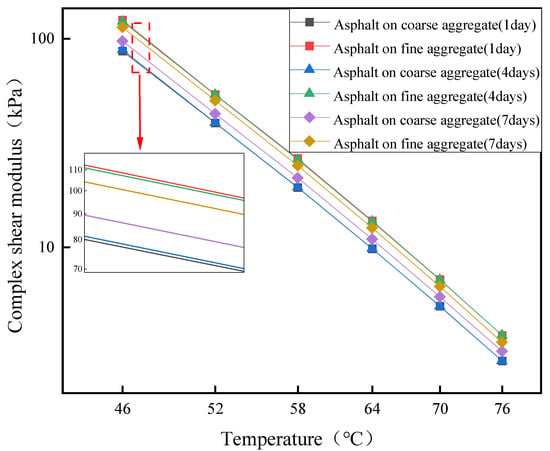
Figure 4.
Temperature scanning of aging asphalt under different placement times.
Figure 4 illustrates noticeable differences in the CSM of asphalt extracted from coarse and fine aggregates that are placed for 1 day, 4 days, and 7 days. This indicates that the DOF of blended asphalt in the RAM does not reach 100% within the specified durations of 1 day, 4 days, and 7 days. Moreover, Figure 4 illustrates that the CSM of the two types of aged asphalt obtained from coarse and fine aggregates gradually approaches as the placement time increases. Specifically, the CSM of the two types of asphalt at 4 days is closer than at 1 day, and the CSM of the two types of asphalt at 7 days is closer than at 4 days. This observation suggests that the aged and fresh asphalt in the recycled material placed at room temperature (30 °C) gradually fuse over time. The figure also reveals that the shear modulus of the two aged asphalts placed for 1 day and 4 days is not significantly different, indicating that the degree of fusion which takes place between 1 day and 4 days experiences only a modest increase. In contrast, the two aged asphalts at 7 days exhibit a noticeable change compared to those at 1 day and 4 days, highlighting a more pronounced increase in the degree of fusion from 4 days to 7 days. This phenomenon is due to the increased severity of asphalt aging in RAP materials as it is further away from the aggregate. Conversely, the degree of aging of asphalt is lower when it is closer to the surface of the aggregate. Fusion of the outer layer is a more time-consuming process, whereas fusion of the inner layers occurs relatively faster.
In this study, the CSM of asphalt at 46 °C was substituted into the above Formula (3) to calculate the DOF of blended asphalt in the RAM at room temperature for 1 day, 4 days, and 7 days. The outcomes are illustrated in Figure 5.
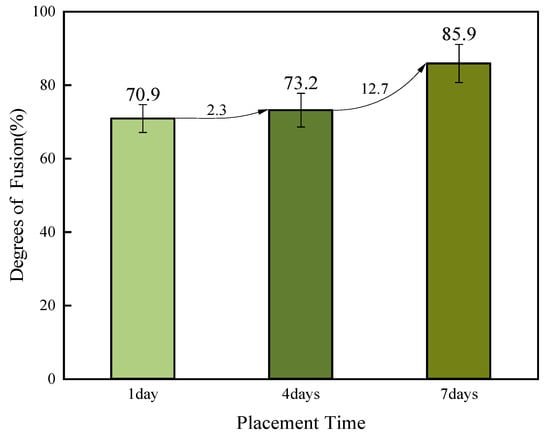
Figure 5.
Fusion degree of the RAM under different placement time.
Figure 5 shows that the fusion degree of the reclaimed asphalt mixture placed for 1 day is 70.9%. This indicates that initially, the blended asphalt in the reclaimed asphalt mixture starts to fuse after mixing, but does not reach complete fusion. The fusion degree increases gradually with time, indicating that the aged and fresh asphalt continue to fuse in the reclaimed asphalt mixture at room temperature until complete integration is achieved.
4.2. Water Stability Test
Figure 6 displays the results of the freeze–thaw splitting test for the RAM without gradation optimization, and three types of RAM with varying placement times.
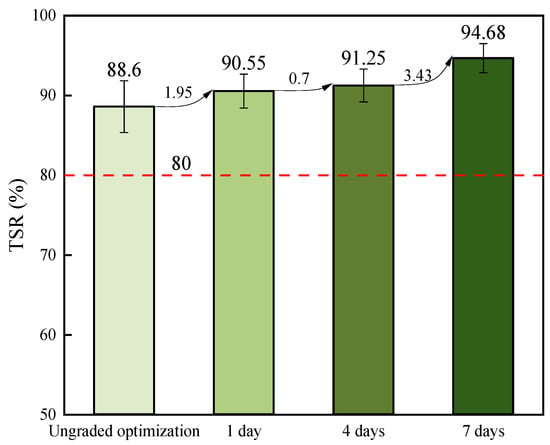
Figure 6.
TSR of recycled asphalt mixture.
To be compliant with JTG F40-2004 standards, the Tensile Strength Ratio (TSR) for SMA with modified asphalt must exceed 80%. From Figure 6, it is evident that both the mixture without gradation optimization and the mixture with three different placement times meet the specified requirements for TSR. Notably, the TSR of the RAM experiences an increase of 1.95 percentage points after gradation optimization. Among the RAM with different placement times, the TSR for 1 day is the lowest, followed by 4 days, and the highest TSR is observed for 7 days. It is evident that the TSR of the RAM increases progressively with the placement time, with the TSR at 7 days being 4.18 percentage points higher than at 1 day. The primary reason for the observed phenomenon is the reduced adhesion between the aged asphalt and the aggregate in long-term service RAP materials, which contain a significant amount of aged asphalt. When the placement time is short, some aged asphalts are not activated by the new asphalt and the regenerant in the RAM. At the enrichment of the aged asphalt, the adhesion of asphalt is low, and it will become a weak point in a warm water environment. It is more likely to be eroded by water in the asphalt film, making the mixture loose, and ultimately reducing its water stability. As time elapses, more aged asphalt is activated and fuses with the new asphalt, gradually reducing these weak points. Therefore, the water stability of RAM has been improved to a certain extent.
The results of the immersion Marshall test for the RAM without gradation optimization and three different RAM with varying placement times are depicted in Figure 7.

Figure 7.
Residual stability of recycled asphalt mixture.
As per the specifications outlined in JTG F40-2004, the residual Marshall stability (RMS) of SMA utilizing modified asphalt must exceed 80%. Figure 7 reveals that the residual stability of both the RAM without gradation optimization, and the three distinct placement times, aligns with the specified requirements. Following gradation optimization, there is a 2.08 percentage point increase in the RMS of the RAM. Among the RAM with different placement times, the 1 day placement has the lowest residual stability, followed by 4 days, while 7 days has the highest residual stability. This indicates that as the placement time increases for the RAM, the RMS gradually improves, with 7 days showing a 2.61 percentage point increase compared to 1 day. The reason for these results is that, while the blending of the RAM is uniform on a macro level, the internal aged asphalt and new asphalt are not fully integrated. There is still a weak stress interface between aged asphalt and fresh asphalt. As time progresses, more and more aged asphalt is activated and fuses with the new asphalt. The weak stress interface in the blended asphalt gradually decreases as the fusion progresses. This indicates a gradual improvement in the water stability of the mixture with the fusion of blended asphalt.
4.3. Low-Temperature Performance Test
The low-temperature bending test results of four types of recycled materials are illustrated in Figure 8.
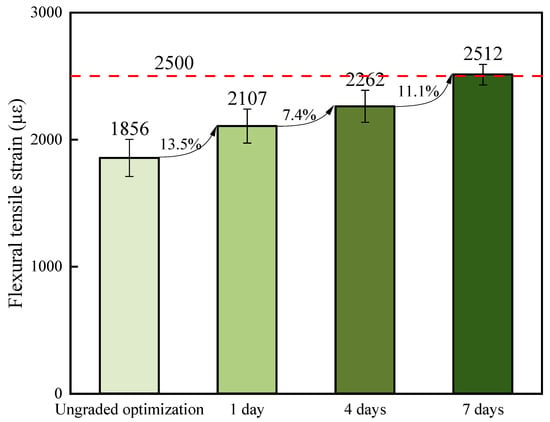
Figure 8.
Low-temperature bending properties of RAM.
As per the specifications of JTG F40-2004, the asphalt mixture’s maximum bending strain, when utilizing modified asphalt in warm winter and cold winter regions, should exceed 2500 µε. Figure 8 illustrates that the low-temperature flexural strains of the unoptimized graded RAM, as well as the RAM placed for 1 day and 4 days, fall short of meeting the specified requirements. Nevertheless, the RAM placed for 7 days conforms to the specified requirements for maximum flexural strain. The inadequate low-temperature performance of the RAM is mainly attributed to the existence of brittle and hardened aged asphalt within the RAP structure. Such asphalt is more susceptible to brittle fractures when exposed to low-temperature environments. In this experiment, a substantial 80% RAP content was used, and the RAP material contained a significant quantity of aged asphalt, rendering it more vulnerable to cracking under low-temperature conditions. As depicted in Figure 8, the flexural strain of the RAM witnessed a 13.5% increase following gradation optimization. The bending strain of the RAM was at its lowest at 1 day and reached its peak at 7 days. The maximum bending strain gradually increased with the extended placement time. The primary cause of this phenomenon is the progressive activation of aging asphalt in RAP under the influence of the regenerating agent and new asphalt, leading to its fusion with the new asphalt over time. As time progresses, an increasing amount of aging asphalt is activated and undergoes fusion, leading to a rise in the effective asphalt content within the mixture. This leads to a more uniform fusion of aged and fresh asphalt over time. The increased fusion time is beneficial for enhancing the uniformity and flexibility of the asphalt. Therefore, the low-temperature performance of the RAM improves with increasing placement time.
4.4. High-Temperature Performance Test
The results of the high-temperature rutting test for the RAM without graded optimization and the RAM with three different placement times are shown in Figure 9.
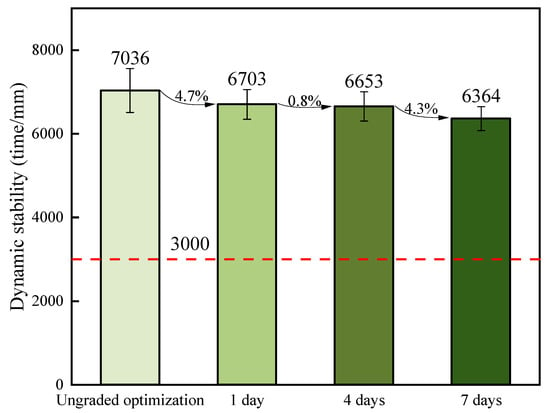
Figure 9.
High-temperature performance of RAM.
According to JTG F40-2004 specifications, the dynamic stability (DS) of modified asphalt SMA must be equal to or greater than 3000 times/mm. Figure 9 demonstrates that the DS of all four RAM significantly surpasses the specified requirements. This is mainly due to the higher RAP content in this material. This aged asphalt is less prone to softening at high temperatures. Figure 9 reveals a 4.7% decrease in the DS of the reclaimed asphalt mixture following gradation optimization.
Comparing the DS of RAM at different placement times reveals that the DS is highest at 1 day, followed by 4 days, with 7 days exhibiting the lowest DS. As the placement time increased, the DS of the RAM gradually decreased. The DS decreased by 5.1% as the placement time progressed from 1 day to 7 days. In summary, the high-temperature performance of RAM experiences a slight decrease as placement time increases. The primary factors are as follows: When placed for 1 day, fusion occurs primarily on the surface of the RAP, with only a small portion of the asphalt activated by the regenerating agent and new asphalt. A significant portion of the aging asphalt does not participate in the fusion but maintains its brittle and hard characteristics, offering strong resistance to shear deformation and exhibiting good high-temperature performance. With the increase in placement time, more and more aging asphalt becomes activated and engages in the fusion process. The rheological properties of aging asphalt improve, rendering the aging asphalt softer when exposed to high temperatures. As a result, its ability to resist high-temperature deformation diminishes, causing a gradual decline in the high-temperature performance.
4.5. Fatigue Performance Test
Figure 10 illustrates the fatigue properties of RAM subjected to various durations of room temperature placement.
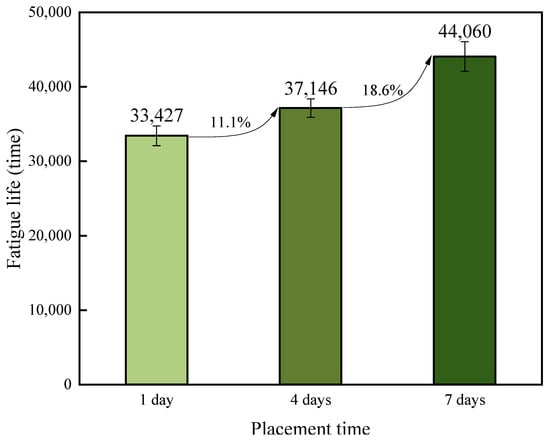
Figure 10.
Fatigue life of RAM.
As depicted in Figure 10, the fatigue life of the RAM progressively rises with prolonged placement time. Specifically, the fatigue life of the RAM after 7 days is 31.8% higher than that after 1 day. This trend indicates that as the placement time is prolonged, the fatigue performance of RAM gradually improves. The primary factor contributing to this enhancement is the elevated RAP content in the RAM, leading to a higher content of aging asphalt. The hardening of the aged asphalt influences the cementing performance of the mixture, especially affecting the interfacial adhesion of the asphalt. This situation is unfavorable for the fatigue cracking performance of the RAM. As the placement time increases, the aging asphalt in the RAP material undergoes more thorough integration with the new asphalt. The weak adhesive interface between the aged and fresh asphalt is enhanced due to the fusion of blended asphalt. The improved bonding properties enhances the fatigue cracking resistance of RAM.
4.6. FTIR Test
The infrared spectrum test results of each layer of recycled asphalt placed for 1 day, 4 days, and 7 days are shown in Figure 11.
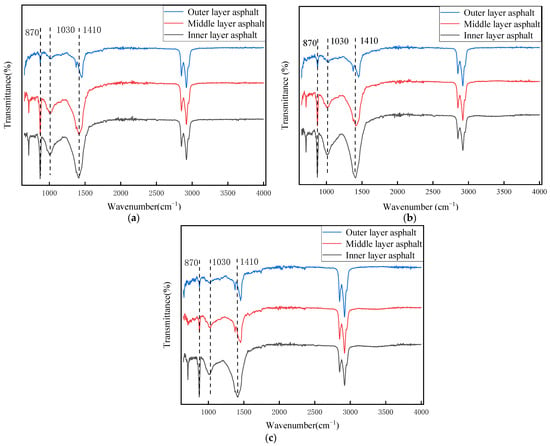
Figure 11.
Infrared spectra of asphalt layers under different placement times: (a) placed for 1 day; (b) placed for 4 days; (c) placed for 7 days.
In Figure 11a, it is evident that the outermost layer of asphalt has weaker absorption peak intensities at the 720~870 cm−1 C-H bond, 1030 cm−1 S=O bond, and 1410 cm−1 O-H bond positions compared to the middle and inner layers. In contrast, the infrared spectrum absorption peak intensities of the middle and inner layers are relatively consistent. As shown in Figure 11b, when the placement time reaches 4 days, the absorption peak intensities at the 720~870 cm−1, 1030 cm−1, and 1410 cm−1 positions for the three layers of asphalt are similar to those at 1 day. Figure 11c reveals that when the placement time reaches 7 days, the absorption peak intensities for the middle layer of asphalt at the 720~870 cm−1, 1030 cm−1, and 1410 cm−1 positions are weakened compared to those at 4 days. Based on these three diagrams, it can be concluded that the infrared spectra of asphalt gradually changes from the outside to the inside with increasing placement time. At 1 day and 4 days, only the absorption peak of the outermost asphalt undergoes significant changes. At 7 days, the absorption peaks of both the outermost and middle layer asphalt show significant changes. This phenomenon can be explained as follows: at 1 day and 4 days, the new asphalt only fuses with the outermost layer of asphalt. At 7 days, the new asphalt fuses with the middle layer and starts to fuse with the innermost layer asphalt. The outermost asphalt has a slower fusion rate.
4.7. SEM Test
The SEM test results present the surface features of RAM at various placement times, as indicated in Figure 12.
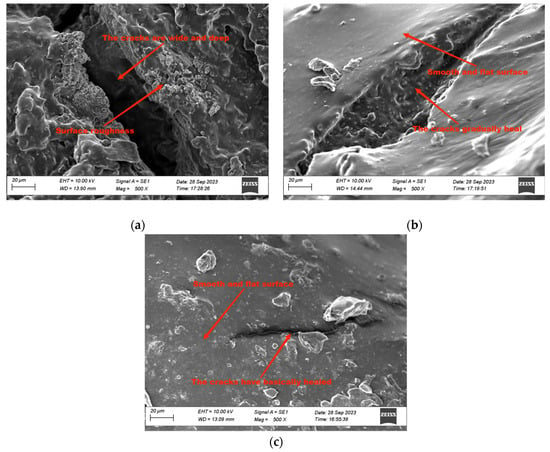
Figure 12.
Surface morphology of RAM at different placement times: (a) placed for 1 day; (b) placed for 4 days; (c) placed for 7 days.
Figure 12 shows that there will be many large and deep cracks on the surface of RAM when it is placed for 1 day, and the surface of RAM is rough. When the placement time reaches 4 days, the bottom of these cracks are filled with recycled asphalt, the cracks are gradually healed, and the surface of the recycled material gradually becomes flat and smooth. When the placement time reaches 7 days, the cracks are basically healed and only a small ‘scar’ structure is left. The reason for the above results is that the aged and fresh asphalt in the RAM gradually merges with the extension of the placement time. The surface of the RAM becomes smoother and the cracks on the surface of the RAM are gradually repaired during the fusion process.
5. Conclusions
This paper studies the road performance and fatigue performance of hot in-place RAM. A temperature scanning test was used to study the DOF trend of blended asphalt in RAM with time. At the same time, a high-temperature rutting test, low-temperature bending test, immersion Marshall test, freeze–thaw splitting test, and splitting fatigue test were carried out on the RAM at different placement times after molding. Finally, the characteristics of asphalt fusion are revealed from a microscopic perspective through an FTIR test and SEM test. The following conclusions are drawn from the above research:
- (1)
- Based on the findings of the temperature scan test, it is evident that the blended asphalt in the reclaimed asphalt mixture exhibits partial fusion after mixing, and the degree of fusion tends to increase progressively with extended placement time.
- (2)
- The water stability and low-temperature crack resistance of RAM are improved by 2% and 13.5% respectively, and the high-temperature rutting resistance will decrease slightly by 4.7% after the gradation optimization. From 1 day to 7 days, as the placement time of the RAM increases, the water stability slightly improves, the low-temperature crack resistance increases by 19.2%, the fatigue life increases by 31.8%, and the high-temperature rutting resistance decreases slightly.
- (3)
- The FTIR and SEM test results show that the aging asphalt in the inner layer is not activated and does not undergo fusion during the mixing of the RAM. The fusion of blended asphalt in the RAM occurs progressively, layer by layer, as time increases; the fusion in the outermost layer is slower.
Further work suggestions: 1. The surface temperature of asphalt pavement in the month with the highest temperature could be recorded, and an approximate simulation could be carried out according to the recorded temperature. The specimen could be placed in a simulated environment, so that the performance change of the recycled mixture is closer to the change of pavement in situ. 2. The placement time of the recycled material could be appropriately extended, so that the development process of the early performance of the recycled mixture would be more complete.
Author Contributions
Conceptualization, Q.S.; methodology, Q.S. and Y.X. (Yanhua Xue); software, Y.X. (Yiyang Xue) and C.Z.; validation, W.L. and Y.W.; formal analysis, C.L., Y.X. (Yanhua Xue) and Y.X. (Yiyang Xue); investigation, Y.X. (Yanhua Xue); resources, C.L.; data curation, Q.S.; writing—original draft preparation, Q.S.; writing—review and editing, C.L.; visualization, W.L.; supervision, Y.X. (Yanhua Xue); project administration, C.Z.; funding acquisition, S.L. All authors have read and agreed to the published version of the manuscript.
Funding
This manuscript is based upon work supported by the National Natural Science Foundation of China (No. 52225806, 52078063, 52208420); the Science and Technology Innovation Plan Project of Hunan province of China (2023RC3144); and the Changsha University of Technology Practice Innovation Project (CLSJCX22022). Any opinions, findings, and conclusions or recommendations expressed in this material are those of the authors and do not necessarily reflect the views of the funders.
Institutional Review Board Statement
Not applicable.
Informed Consent Statement
Not applicable.
Data Availability Statement
Data are contained within the article.
Conflicts of Interest
Author Chen Zhang was employed by the company Jiangsu Jitri Road Engineering Technology and Equipment Research Institute Co., Ltd. The remaining authors declare that the research was conducted in the absence of any commercial or financial relationships that could be construed as a potential conflict of interest.
References
- Yi, X.; Dong, R.; Tang, N. Development of a novel binder rejuvenator composed by waste cooking oil and crumb tire rubber. Constr. Build. Mater. 2020, 236, 117621. [Google Scholar] [CrossRef]
- Xue, Y.; Liu, C.; Lv, S.; Ge, D.; Ju, Z.; Fan, G. Research on rheological properties of CNT-SBR modified asphalt. Constr. Build. Mater. 2022, 361, 129587. [Google Scholar] [CrossRef]
- Yi, X.; Chen, H.; Wang, H.; Shi, C.; Yang, J. The feasibility of using epoxy asphalt to recycle a mixture containing 100% reclaimed asphalt pavement (RAP). Constr. Build. Mater. 2022, 319, 126122. [Google Scholar] [CrossRef]
- Liu, C.; Zhao, B.; Xue, Y.; He, Y.; Ding, S.; Wen, Y.; Lv, S. Synchronous method and mechanism of asphalt-aggregate separation and regeneration of reclaimed asphalt pavement. Constr. Build. Mater. 2023, 378, 131127. [Google Scholar] [CrossRef]
- Remišová, E.; Decký, M.; Mikolaš, M.; Hájek, M.; Kovalčík, L.; Mečár, M. Design of Road Pavement Using Recycled Aggregate. IOP Conf. Ser. Earth Environ. Sci. 2016, 44, 022016. [Google Scholar] [CrossRef]
- Zhang, J.; Guo, C.; Chen, T.; Zhang, W.; Yao, K.; Fan, C.; Liang, M.; Guo, C.; Yao, Z. Evaluation on the mechanical performance of recycled asphalt mixtures incorporated with high percentage of RAP and self-developed rejuvenators. Constr. Build. Mater. 2021, 269, 121337. [Google Scholar] [CrossRef]
- Xue, Y.; Liu, C.; Qu, J.; Lv, S.; Ju, Z.; Ding, S.; An, H.; Ren, K. Research on pavement performance of recycled asphalt mixture based on separation technology of asphalt and aggregate in RAP. Constr. Build. Mater. 2023, 393, 132103. [Google Scholar] [CrossRef]
- Niu, W. Present Situation and Development Course of Hot In-place Recycling Technology of Asphalt Pavement. J. China Foreign Highw. 2019, 39, 50–59. [Google Scholar] [CrossRef]
- Foroutan Mirhosseini, A.; Kavussi, A.; Tahami, S.A.; Dessouky, S. Characterizing temperature performance of bio-modified binders containing RAP binder. J. Mater. Civ. Eng. 2018, 30, 04018176. [Google Scholar] [CrossRef]
- Li, J.; Zhang, X.; Wei, H.; Zhu, H.; Tang, B. Evaluation of volatile organic compounds emissions and rheological properties of Buton rock asphalt modified asphalt. Constr. Build. Mater. 2023, 408, 133575. [Google Scholar] [CrossRef]
- Lei, Y.; Wang, H.; YOU, Z.; Wang, Y.; Jiang, X.; Gao, J. Effect of Mixing Sequence on Compaction Characteristics of Hot Recycled Asphalt Mixture. Eng. J. Wuhan Univ. 2019, 52, 317–323+330. [Google Scholar] [CrossRef]
- Xue, Y.; Liu, C.; Shi, Q.; Ju, Z.; Fan, G.; Zhang, C.; Lv, S. Road performance and mechanism of Hot in-place recycling asphalt mixture modified by direct-to-plant SBS. Constr. Build. Mater. 2024, 416, 135122. [Google Scholar] [CrossRef]
- Hassan, H.F. Recycling of municipal solid waste incinerator ash in hot-mix asphalt concrete. Constr. Build. Mater. 2005, 19, 91–98. [Google Scholar] [CrossRef]
- Sun, J.; Lu, P.; Hasegawa, K. Cause analysis of the fire and explosion of asphalt–salt mixture in a nuclear wastes processing plant. Fire Saf. J. 2005, 40, 411–424. [Google Scholar] [CrossRef]
- Jeong, K.-D.; Lee, S.-J.; Kim, K.W. Laboratory evaluation of flexible pavement materials containing waste polyethylene (WPE) film. Constr. Build. Mater. 2011, 25, 1890–1894. [Google Scholar] [CrossRef]
- Ahmadinia, E.; Zargar, M.; Karim, M.R.; Abdelaziz, M.; Shafigh, P. Using waste plastic bottles as additive for stone mastic asphalt. Mater. Des. 2011, 32, 4844–4849. [Google Scholar] [CrossRef]
- Chen, L.; He, Z.; Chen, H.; Wang, X.; Xiang, H. Study on Regeneration Rheological Characteristics and Molecular Dynamics Simulation of New-Old Asphalt Interface. China J. Highw. Transp. 2019, 32, 25–33. [Google Scholar] [CrossRef]
- Orešković, M.; Menegusso Pires, G.; Bressi, S.; Vasconcelos, K.; Lo Presti, D. Quantitative assessment of the parameters linked to the blending between reclaimed asphalt binder and recycling agent: A literature review. Constr. Build. Mater. 2020, 234, 117323. [Google Scholar] [CrossRef]
- Lo Presti, D.; Vasconcelos, K.; Orešković, M.; Pires, G.M.; Bressi, S. On the degree of binder activity of reclaimed asphalt and degree of blending with recycling agents. Road Mater. Pavement Des. 2020, 21, 2071–2090. [Google Scholar] [CrossRef]
- Zhao, S.; Huang, B.; Shu, X.; Woods, M.E. Quantitative characterization of binder blending: How much recycled binder is mobilized during mixing? Transp. Res. Rec. 2015, 2506, 72–80. [Google Scholar] [CrossRef]
- Zaumanis, M.; Mallick, R.B.; Poulikakos, L.; Frank, R. Influence of six rejuvenators on the performance properties of Reclaimed Asphalt Pavement (RAP) binder and 100% recycled asphalt mixtures. Constr. Build. Mater. 2014, 71, 538–550. [Google Scholar] [CrossRef]
- Gao, J.; Wang, H.; Liu, C.; Ge, D.; You, Z.; Yu, M. High-temperature rheological behavior and fatigue performance of lignin modified asphalt binder. Constr. Build. Mater. 2020, 230, 117063. [Google Scholar] [CrossRef]
- Zhao, S.; Zhang, H.; Gao, M.; Zhang, Q.; Sun, Q.; Dong, Q. Nano-microscopic analysis on the interaction of new and old asphalt mortar in recycled asphalt mixture. Chem. Phys. Lett. 2023, 825, 140593. [Google Scholar] [CrossRef]
- Ren, S.; Liu, X.; Lin, P.; Gao, Y.; Erkens, S. Insight into the compatibility behaviors between various rejuvenators and aged bitumen: Molecular dynamics simulation and experimental validation. Mater. Des. 2022, 223, 111141. [Google Scholar] [CrossRef]
- Bowers, B.F.; Huang, B.; Shu, X.; Miller, B.C. Investigation of Reclaimed Asphalt Pavement blending efficiency through GPC and FTIR. Constr. Build. Mater. 2014, 50, 517–523. [Google Scholar] [CrossRef]
- Ding, L.; Wang, X.; Zhang, M.; Chen, Z.; Meng, J.; Shao, X. Morphology and properties changes of virgin and aged asphalt after fusion. Constr. Build. Mater. 2021, 291, 123284. [Google Scholar] [CrossRef]
- Zou, G.; Zhang, J.; Li, Y.; Lin, Z. Quantitative characterize binder blending and diffusion in recycled asphalt mixture: An environmental-friendly solution using wooden cube and 3D fluorescence image technology. J. Clean. Prod. 2021, 293, 126204. [Google Scholar] [CrossRef]
- Ding, Y.; Huang, B.; Shu, X. Characterizing blending efficiency of plant produced asphalt paving mixtures containing high RAP. Constr. Build. Mater. 2016, 126, 172–178. [Google Scholar] [CrossRef]
- Yang, C.; Wu, S.; Xie, J.; Amirkhanian, S.; Zhao, Z.; Xu, H.; Wang, F.; Zhang, L. Development of blending model for RAP and virgin asphalt in recycled asphalt mixtures via a micron-Fe3O4 tracer. J. Clean. Prod. 2023, 383, 135407. [Google Scholar] [CrossRef]
- Bowers, B.F.; Moore, J.; Huang, B.; Shu, X. Blending efficiency of Reclaimed Asphalt Pavement: An approach utilizing rheological properties and molecular weight distributions. Fuel 2014, 135, 63–68. [Google Scholar] [CrossRef]
- Yang, C.; Xie, J.; Wu, S.; Amirkhanian, S.; Wang, Z.; Song, J.; Zhou, X.; Wang, F.; Zhang, L. Enhancement mechanism of induction heating on blending efficiency of RAP—virgin asphalt in steel slag recycled asphalt mixtures. Constr. Build. Mater. 2021, 269, 121318. [Google Scholar] [CrossRef]
- Hettiarachchi, C.; Hou, X.; Xiang, Q.; Yong, D.; Xiao, F. A blending efficiency model for virgin and aged binders in recycled asphalt mixtures based on blending temperature and duration. Resour. Conserv. Recycl. 2020, 161, 104957. [Google Scholar] [CrossRef]
- Li, D.; Leng, Z.; Zhang, S.; Jiang, J.; Yu, H.; Wellner, F.; Leischner, S. Blending efficiency of reclaimed asphalt rubber pavement mixture and its correlation with cracking resistance. Resour. Conserv. Recycl. 2022, 185, 106506. [Google Scholar] [CrossRef]
- Cui, B.; Wang, H.; Gu, X.; Hu, D. Study of the inter-diffusion characteristics and cracking resistance of virgin-aged asphalt binders using molecular dynamics simulation. Constr. Build. Mater. 2022, 351, 128968. [Google Scholar] [CrossRef]
- Gao, J.; Yao, Y.; Yang, J.; Song, L.; Xu, J.; He, L.; Tao, W. Migration behavior of reclaimed asphalt pavement mastic during hot mixing. J. Clean. Prod. 2022, 376, 134123. [Google Scholar] [CrossRef]
- Li, M.; Ren, S.; Liu, X.; Wu, Z.; Zhang, H.; Fan, W.; Lin, P.; Xu, J. A Comprehensive Study on the Rejuvenation Efficiency of Compound Rejuvenators for the Characterization of the Bituminous Binder, Mortar, and Mixture. Materials 2022, 15, 5458. [Google Scholar] [CrossRef] [PubMed]
- Wang, T.; Jiang, W.; Xiao, J.; Guo, D.; Yuan, D.; Wu, W.; Wang, W. Study on the blending behavior of asphalt binder in mixing process of hot recycling. Case Stud. Constr. Mater. 2022, 17, e01477. [Google Scholar] [CrossRef]
- Xu, J.; Hao, P.; Zhang, D.; Yuan, G. Investigation of reclaimed asphalt pavement blending efficiency based on micro-mechanical properties of layered asphalt binders. Constr. Build. Mater. 2018, 163, 390–401. [Google Scholar] [CrossRef]
- JTG E20-2011; Test Procedure for Asphalt and Asphalt Mixture of Highway Engineering. Research Institute of Highway, Ministry of Transport: Beijing, China, 2011; 373p, A374.
- JTG F40-2004; Technical Specifications for Construction of Highway Asphalt Pavements. Institute of Highway Science, Ministry of Transportation: Beijing, China, 2004; 196p, A194.
- JTG E42-2005; Test Methods of Aggregate for Highway Engineering. Institute of Highway Science, Ministry of Transportation: Beijing, China, 2005; 147p, A144.
- Zhang, D.; Xv, J.; Hao, P.; Bowers, B.F.; Huang, B.; Shu, X.; Miller, B.C. Study on the fusion degree of old and new asphalt in recycled mixture based on GPC and FTIR. Sino-Foreign Highw. 2016, 36, 214–219. [Google Scholar] [CrossRef]
Disclaimer/Publisher’s Note: The statements, opinions and data contained in all publications are solely those of the individual author(s) and contributor(s) and not of MDPI and/or the editor(s). MDPI and/or the editor(s) disclaim responsibility for any injury to people or property resulting from any ideas, methods, instructions or products referred to in the content. |
© 2024 by the authors. Licensee MDPI, Basel, Switzerland. This article is an open access article distributed under the terms and conditions of the Creative Commons Attribution (CC BY) license (https://creativecommons.org/licenses/by/4.0/).